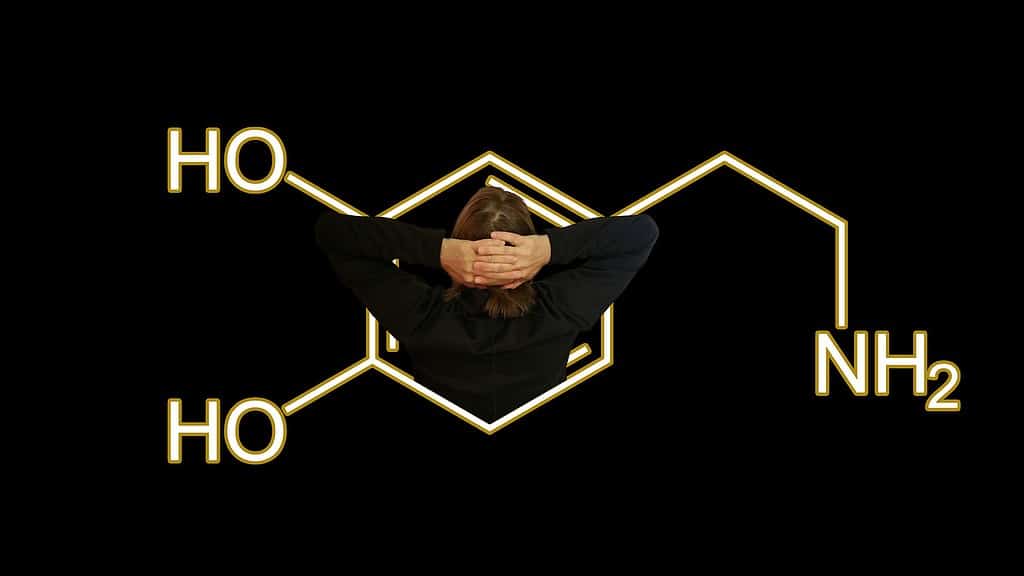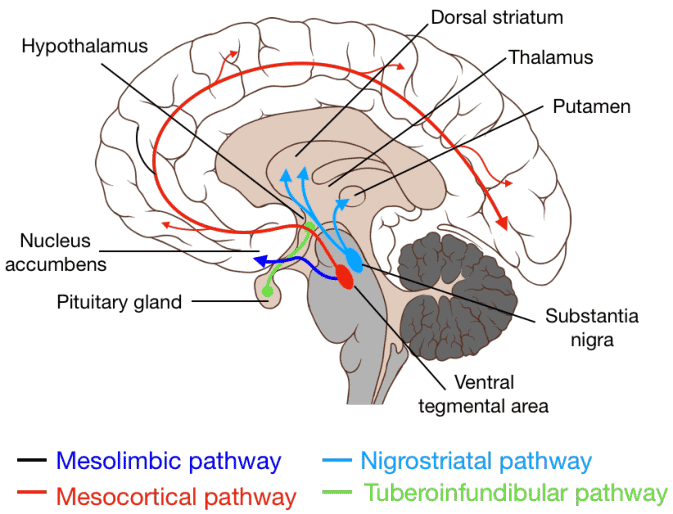
Eating a delicious meal, having sex, listening to music, or even receiving praise can trigger a rush of euphoria. This feeling of satisfaction and joy is owed to the most famous neurotransmitter in neuroscience, dopamine.
What is dopamine?

Dopamine is often called the “pleasure” or “feel-good” chemical in the brain — and for good reason, too. Dopamine is a vital chemical messenger in our brains, responsible for pleasurable sensations when we both anticipate and receive a reward. This drives us to seek out pleasurable stimuli in the future, greatly affecting our behavior for better or worse.
Dopamine is part of a select club of neurotransmitters — along with serotonin, endorphins, and oxytocin — colloquially known as the “happy chemicals.
However, in addition to mood, dopamine is also responsible for changes in movement, memory, and focus. Dopamine can also boost empathy and creativity, as well as make us more social and extroverted.
But it’s not all bliss and joy when speaking about dopamine. There’s a dark side to it, too.
The same dopamine pathways in the brain that lead us to seek out pleasurable experiences can be hijacked by powerful drugs like alcohol and cocaine, causing addiction. And when there’s too little or too much dopamine in your system, there’s a risk of developing serious diseases and conditions like Parkinson’s.
As it turns out, the secret to what makes dopamine a “happiness chemical” rather than a “sadness chemical” is all about achieving neurochemical balance.
Let’s take a closer look at how dopamine drives our mood and behavior.
How is dopamine released in the brain?

Dopamine is produced at the base of the brain in a two-step process.
- First, the amino acid tyrosine is broken down into another amino acid, known as L-dopa.
- Then, the L-dopa amino acid undergoes yet another conversion mitigated by enzymes in the brain, finally turning it into dopamine.
Once produced, dopamine is released into various regions of the brain, including:
- the striatum (processes decision-making, motivation, reinforcement, reward perception),
- amygdala (processes fearful and threatening stimuli),
- and prefrontal cortex (involved in planning, decision making, personality expression, and social behavior).
Neurons in these regions are connected to the nucleus accumbens, a key region of the brain’s reward center. Here, dopamine regulates reward-associated behavior by triggering feelings of accomplishment and pleasure associated with completing a certain task.
It is this dopamine release in the nucleus accumbens that reinforces the behavior that led to the pleasurable experience, making us more likely to repeat that behavior in the future. This feedback loop is what underlies the motivational and rewarding aspects of dopamine.
The release of dopamine in the brain is also influenced by other neurotransmitters, such as glutamate and GABA. Glutamate, an excitatory neurotransmitter, stimulates the release of dopamine, while GABA, an inhibitory neurotransmitter, reduces dopamine release.
The balance between these neurotransmitters is critical for maintaining proper dopamine levels in the brain.
When is dopamine produced?
The release of dopamine is triggered by rewarding experiences, such as eating a delicious meal, receiving praise for a job well done, or achieving a personal goal. But that’s just one side of the story.
More recent studies have shown that dopamine is also released in large amounts when we anticipate a pleasurable experience. In many cases, the anticipation of a rewarding experience can trigger much more dopamine than achieving the reward itself — so much so that scientists are now calling dopamine the “anticipation molecule” rather than the “happy” molecule.
This new paradigm shift in how scientists view the role of dopamine in the brain makes a lot of sense from an evolutionary standpoint. Seeking out rewarding experiences such as food and sex, while avoiding unpleasant stimuli like pain is essential to both survival and reproduction.
But rewards are relatively rare episodes in our daily lives. Anticipation can fill the gap, keeping us motivated to carry on with sometimes uncomfortable tasks as long as experience thought us that a reward awaits us down the road once the task is complete.
If you’re looking for a quick primer on how anticipation and dopamine are related, Professor Robert Sapolsky of Stanford University has got you covered in this brief video.
Uncertainty doubles dopamine release
In his study, Sapolsky trained monkeys to associate a light (the stimulus) with a reward. The monkey learned that if they pressed a button ten times after the lights came on, then on the tenth press a delicious treat would appear.
Sapolsky and colleagues measured the amount of dopamine released in the monkeys’ brains, as well as the timing of this release during the three-step cycle:
- stage 1: the signal (light) is introduced
- stage 2: work commences (pressing the button)
- stage 3: reward (the food treat)
What the scientists found was nothing short of extraordinary. Dopamine releases started immediately after the signal was introduced, peaked before work, and ended before the reward was actually presented.
But the second part of the experiment was even more staggering. This time, the scientists switched things around and the monkeys received the treat only 50% of the time after they finished pressing the button ten times.
By tying uncertainty to the reward, the amount of dopamine produced in the brain skyrocketed.

The uncertainty of receiving the delicious treat is driving a greater expectation and therefore a great dopamine production. For a monkey, the reward can be a grape, whereas for humans it can be anything from a new pair of shoes to early retirement.
Happy chemicals now, sad chemicals later
These findings perfectly illustrate the association between pathological gambling and dopamine production. Casinos basically play dirty neuroscience tricks on their patrons by providing the opportunity to win an extremely appealing financial reward but with extremely low odds.
It’s not the prize that keeps gamblers coming back for more despite huge losses, but rather the anticipation of the reward which is highest when the roulette wheel is spinning or when the next card in the deck is about to be revealed.
This phenomenon can also explain social media use. The anticipation of new likes and comments on our posts keeps us glued to smartphone screens. This is, of course, by design as all the major tech companies in the world have neuroscientists on their staff to tweak the user interface for optimal dopamine release in order to motivate users to use their apps again and again.
Tristan Harris, a former user interface designer at Google turned social activist, explains how these nefarious tactics work. He likens it to literally brain hacking.
In today’s modern-day life packed with digital avatars and personas, every second provides an opportunity to be stimulated, whether it’s online gambling or e-shopping.
This brings us to the next chapter in this supposedly happy chemical saga: addiction.
How dopamine contributes to addiction

While dopamine release is critical for pleasure and motivation, it can also have a dark side.
Scientists now know that the higher the dopamine release of an experience, the more addictive it becomes.
Our brains get a dopamine rush when we anticipate something pleasurable as well as when we experience the thing itself. Once the “work” is done, the brain goes through a dopamine dip or comedown.
This is because of a fundamental principle in brain chemistry: homeostasis.
For every high, there is a low. That’s because homeostasis seeks to keep the brain in a chemical balance in order to achieve a neutral state of consciousness.
In this neutral state, we are not too aroused, but not too understimulated either. It’s an optimal state of vigilance, which provides the best opportunities for survival and replication, explaining why the brain is hardwired to seek this state.
In more relatable terms, these dips in dopamine can translate into cravings. We really want that second piece of chocolate or to watch another episode of that engaging show that hits our dopamine receptors hard.
We all know these cravings are annoying but they’re fleeting and manageable.
However, when an experience bombards us with an unnaturally high level of dopamine and we have repeated this dopamine-producing experience enough times, that’s when addiction sets in. We are no longer talking about a trifling craving.
“The white powder of cocaine has no intrinsic value to the nervous system until someone takes it, perhaps repeatedly,” says Read Montague of the Virginia Tech Carilion Research Institute. “However, its influence on dopamine signaling causes the entire system to learn to value this powder and the behavioral settings that lead to it.”
When we engage in addictive behaviors, such as drug use, gambling, or compulsive eating, dopamine floods the brain, creating a surge of pleasure.
Over time, our brains become desensitized to the effects of dopamine, requiring more and more of the addictive thing or experience to achieve the same level of pleasure.
This desensitization is what leads to addiction, as the brain becomes dependent on dopamine release to achieve homeostasis.
Think of it this way. Say you compare two people, Bob and Jay. Bob has been drinking four cups of coffee every day for the last ten years. Jay has never touched a mug of coffee in his life.
Bob wakes up cranky and sleepy every morning, which is why he loves coffee because it supposedly ‘wakes him’ up. However, this is more of an illusion.
Bob’s brain anticipates a rush of caffeine is due each morning, which is why its biochemistry is “negative” sort to speak in order to get to “zero” once the caffeine is ingested. In this case of prolonged consumption, Bob reaps no added value from drinking so much coffee but is rather just canceling the negative effects of caffeine withdrawal.
Meanwhile, Jay wakes up perfectly fine because his brain is already in homeostasis.
Too much or too little dopamine can cause schizophrenia and Parkinson’s

For most people, dopamine in the brain can be safely classed as a happiness chemical. But abnormal levels of dopamine are associated with a range of mental health conditions, including schizophrenia and Parkinson’s disease.
In schizophrenia, there is an excess of dopamine activity, leading to symptoms such as hallucinations, delusions, and disorganized thinking. Drugs that block dopamine receptors have been shown to control schizophrenic symptoms.
Meanwhile, in Parkinson’s disease, there is a deficiency of dopamine, leading to motor symptoms such as tremors and difficulty with movement. There are over 1.5 million people with Parkinson’s in the United States alone.
Research suggests that low levels of dopamine disrupt the nigrostriatal pathway, which helps facilitate movement. This disruption can cause abnormal nerve firing, explaining the tremours and difficulty coordinating the body in Parkinson’s disease.
“Dysfunctional dopamine signaling is implicated in several neuropsychological disorders, including Parkinson’s disease, drug addiction, and schizophrenia. Therefore, understanding the underlying pathway is crucial for treating several psychiatric diseases,” says Dr. Daisuke Tsuboi of Fujita Health University in Japan.
Dopamine also plays a role in mood disorders such as depression and anxiety. While the exact mechanisms are not fully understood, it is thought that imbalances in dopamine levels may contribute to these conditions.
In depression, for example, there may be a deficiency of dopamine in the brain’s reward center, leading to a lack of motivation and pleasure.
In contrast, anxiety may be associated with an excess of dopamine activity, leading to heightened arousal and feelings of distress.
How to boost dopamine in the brain

Dopamine levels can decrease due to factors such as stress, lack of sleep, and poor nutrition. This can lead to feelings of fatigue, apathy, and even depression. To work as a happy chemical, dopamine needs to be found in optimal amounts.
However, there are natural ways to boost dopamine levels in your brain, according to science.
Exercise regularly
Exercise is one of the best ways to boost dopamine levels naturally. When you exercise, your brain releases a ton of endorphins but also dopamine, which makes you feel good and motivated.
Research has shown that regular exercise can increase dopamine receptor density in the brain, which can lead to increased levels of dopamine production over time. For this reason, exercise is particularly advised for Parkinson’s patients.
Eat a balanced diet (and especially protein)
Your brain needs the right nutrients to produce dopamine, so it’s important to eat a balanced diet that includes protein, healthy fats, and complex carbohydrates.
Foods such as eggs, nuts, and lean meats are great sources of protein, while avocado and olive oil are rich in healthy fats. Complex carbohydrates like whole grains, fruits, and vegetables can help regulate blood sugar levels, which can also have a positive impact on dopamine levels.
If you really want to dial down your brain chemistry, try foods rich in L-dopa, the precursor to the happy molecule. These include:
- Mucuna pruriens (also known as velvet bean)
- Fava beans
- Broad beans
- Soybeans
- Kidney beans
- Navy beans
- Black beans
- Lentils
- Chickpeas
- Almonds
Get enough sleep
Getting enough sleep is essential for overall health, but it also plays a crucial role in dopamine production. During sleep, your brain removes toxins and restores itself, which can help increase dopamine production.
Lack of sleep, on the other hand, can lead to decreased dopamine levels and feelings of fatigue and irritability.
Practice mindfulness
Mindfulness practices such as meditation and yoga can help increase dopamine levels in the brain. Research has shown that regular mindfulness practice can increase grey matter density in the prefrontal cortex, which is responsible for regulating emotions and decision-making. This, in turn, may boost dopamine production and improve well-being.
Listen to music
Music has been shown to have a positive impact on mood and can increase dopamine levels in the brain. When you listen to music that you enjoy, your brain releases dopamine, which can lead to feelings of pleasure and motivation. So next time you’re feeling down, put on your favorite tunes and let the dopamine flow.
Set goals and celebrate success
Setting goals and achieving them can have a positive impact on dopamine levels in the brain. When you set a goal and work towards achieving it, your brain releases dopamine in anticipation of the reward.
When you achieve the goal, your brain releases even more dopamine, which can lead to feelings of pleasure and motivation. So don’t be afraid to set goals and celebrate your successes, no matter how small they may be.
Try supplements
Some supplements may increase dopamine levels in the short term, but the long-term effects are not well understood.
For example, some studies have suggested that supplements such as tyrosine and phenylalanine, which are precursors to dopamine, may increase dopamine levels in the brain. However, other studies have found no significant effects on dopamine levels from these supplements.
Similarly, some herbal supplements such as ginkgo biloba and ginseng have been suggested to increase dopamine levels, but the evidence is inconclusive. More research is needed to determine the safety and effectiveness of these supplements for dopamine production.
It’s important to note that taking supplements can have potential side effects and can interact with other medications. Therefore, it’s recommended to consult with a healthcare provider before taking any supplements to increase dopamine levels.
Dopamine is a vital chemical messenger in our brains, responsible for pleasure, motivation, and reward. Its role in our brain function has led to a deeper understanding of why dopamine makes us happy. While dopamine can have a dark side, understanding its power can help us harness its benefits to improve our well-being.
FAQ about dopamine
Dopamine is a neurotransmitter, a chemical messenger in the brain that plays a critical role in pleasure, motivation, and reward. It is often called the “feel-good” or “happy” chemical.
Dopamine is released in response to rewarding experiences, such as eating a delicious meal or achieving a personal goal. It is also released during anticipation of a reward.
Dopamine plays a critical role in motivation, reward, addiction, social bonding, and more. It can impact our mood, creativity, and problem-solving abilities.
Engaging in activities that release dopamine, fostering positive relationships, and seeking treatment when needed can help us boost our mood, increase motivation, and improve our overall well-being.
Abnormal levels of dopamine are associated with a range of mental health conditions, including schizophrenia and Parkinson’s disease. Excessive dopamine release due to addictive behaviors can also lead to addiction and other negative consequences.







